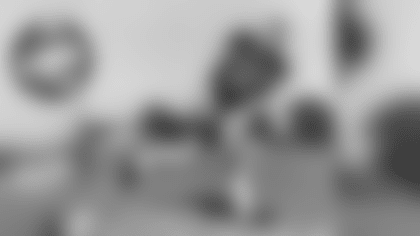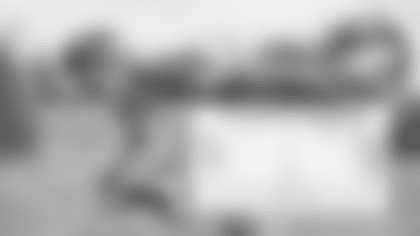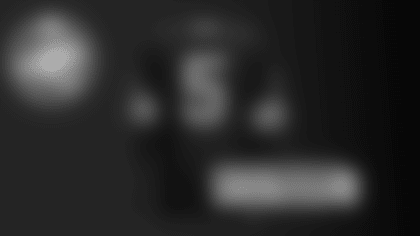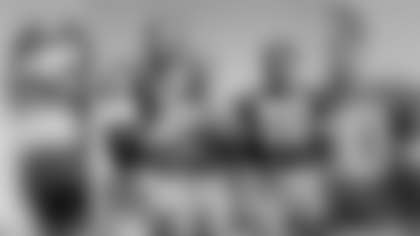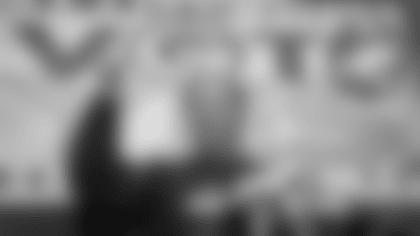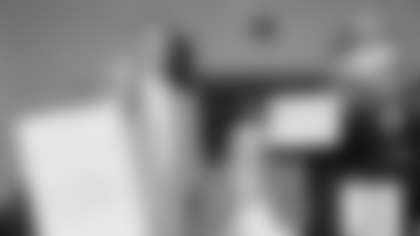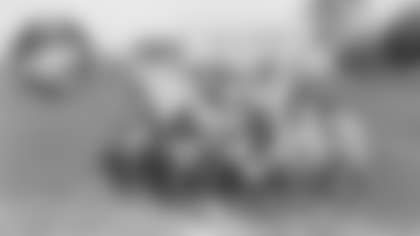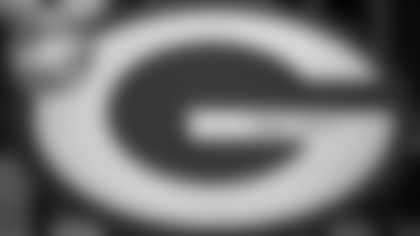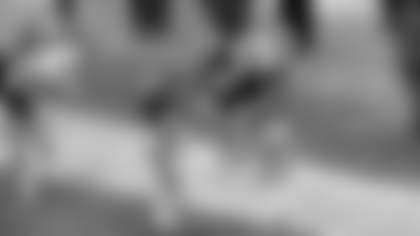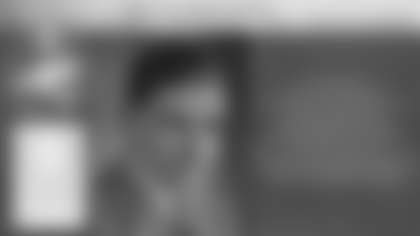Carson from Albany, OR
What are your thoughts about former Green Bay Packer offensive end Billy Howton being a Pro Football Hall of Fame candidate?
My short answer is: I don't think he's a Hall of Fame player. I think the Packers have a number of other senior candidates who were standouts on multiple championship teams that would be better choices.
No doubt, Howton had the stats, Pro Bowl appearances and natural talent to be a hall candidate. But there's more to the game than just a player's numbers, although that seems to be the overriding criteria today.
I have a file with close to 50 interviews with Packers who played in the 1950s. In the case of some key players, I have multiple interviews. Plus, those transcriptions run up to 11 typewritten pages in length and many focus on probing questions about players' strengths and weaknesses from that period.
I also have a file of about dozen interviews with players on opposing teams.
Bottom line: I trust those evaluations more than stat lines.
Let's start with Howton's pluses.
There are few players and/or coaches whose evaluations I trusted more than Raymond Berry. As a Hall of Fame offensive end with the Baltimore Colts from 1955-67, Berry was widely recognized for being a student of the game. Later, he served as head coach of the New England Patriots from 1984-89, leading them to the Super Bowl in 1985. Berry also served as an assistant coach for 13 seasons, starting under Dallas' Tom Landry in 1968 and ending with a one-year stint as quarterbacks coach of the Denver Broncos in 1992.
There might not have been a more credible authority on players from the mid-1950s through the 1990s than Berry.
Here's what he told me about Howton in a 2009 interview.
"He was extremely professional in his pass routes. He knew what he was doing to maneuver and fake to get open. He was an extremely dangerous receiver and had great technique. The rules and the 16-game schedule have skewed the numbers. One of the yardsticks that I think applies no matter what era you're talking about: When this guy retired where did he rank? When (Howton) retired he was the all-time leading receiver. It indicates a consistency over a period of time and high production over a period of time. Howton had that."
When safety Emlen Tunnell retired as a player following the 1961 season, he held the NFL record for most interceptions. He played for the New York Giants from 1948-58 before finishing his career with the Packers from 1959-61, when Vince Lombardi also employed him as an offseason scout. Then from 1963-73, Tunnell served as a scout and assistant coach for the Giants.
"For my money, Howton is the toughest pass receiver to cover in the National League," Tunnell said before the January 1958 Pro Bowl.
Teammates, as well, were dazzled by Howton's ability.
"He made me a better defensive back," Pro Football Hall of Fame safety Bobby Dillon told me in 2015. "Working against him in practice helped me a lot. … He had good moves and great speed. He was a high hurdler in college. He was tough to cover. All of it."
But on the flip side there also were former teammates who believed Howton was such an undermining influence as a star player that he contributed to the Packers' woeful 26-56-1 record during his seven seasons in Green Bay.
Before getting into the reasons why, it should be pointed out that Howton was a driving force behind the creation of the NFL Players Association and then became its first president. As a result, there were teammates who also appreciated his efforts to get them more money and better working conditions.
In a 2006 Coffin Corner story written by John Maxymuk and published by the Professional Football Researchers Association, it was stated that Howton believed he was traded by Lombardi before the 1959 season due to him being the team's player representative.
That's a claim that can't be easily dismissed. As late as 1974, former center Ken Bowman paid that price for being the Packers' player rep during that summer's strike by NFL players.
Lombardi insisted otherwise in a 1960 Chicago Tribune story written by Cooper Rollow, longtime Chicago Bears beat writer.
"The holdovers had to be taught that victory was probable, not impossible," Lombardi told Rollow. "We simply had to get rid of those players who clung to the team's former defeatist attitude."
Lombardi called the Howton trade to Cleveland for defensive end Bill Quinlan and halfback Lew Carpenter "a calculated gamble," adding, "Billy was a fine end, but we felt he had the wrong attitude. So we made an example of him."
In this case, what lends credence to Lombardi's contention that trading Howton was a necessity for the Packers to start winning – not an act of retribution for his role with the NFLPA – was the number of 1950s Packers who agreed with him.
In 2007, when I asked Jim Temp, a defensive end for the Packers from 1957-60 and later a member of the franchise's executive committee, if Howton was a clubhouse lawyer, he responded, "That's exactly what he was."
What's more, Temp said it was Howton who convinced coach Scooter McLean early in the 1-10-1, 1958 season to take it easy on the players in practice. "He said, 'You can't have us do all these drills or we're not going to have our legs,'" Temp said in reference to Howton. "So all of a sudden the practices were like nothing."
Fullback and kicker Fred Cone, who played for the Packers from 1951-57, asked me in a September 2000 interview, "Remember Bill Howton?"
Then Cone answered his own question by explaining how Howton undercut Lisle Blackbourn's credibility with his players. "Bill nicknamed him 'The Lizard,'" said Cone. "That's not showing much respect for the head coach." Hired in 1954, Blackbourn was fired by the Packers after the 1957 season, partly because of the ill will that existed between him and certain veteran players.
Paul Hornung, called by Lombardi "the greatest player I ever coached," told the Green Bay Press-Gazette in 1998 that while there were nine future Pro Football Hall of Famers on the 1958 Packers, there were egos that contributed to their 1-10-1 finish.
"For instance, there was Billy Howton, who was one of the greatest receivers of all time," said Hornung. "But all he wanted to know was where he stood in number of receptions and yards and that kind of stuff. We just didn't know what we were doing until Vince came along."
Arguably, no player suffered more from Howton's subversive actions than Bart Starr, who had an 0-14-1 record as the Packers' starting quarterback in 1957 and '58, not counting three games he started that were won by Babe Parilli in relief.
When Blackbourn traded star quarterback Tobin Rote to Detroit before the 1957 season, Howton lost his pal and a former Rice University teammate. Starr, then in his second year, inherited the starting job. However, based on several accounts, Starr lacked confidence at that point, and Howton all but shattered it by second-guessing his play calls.
"No small amount of Green Bay's offense problem last season could be charged to indecision and uncertainty of the quarterbacks," Chuck Johnson, Packers beat reporter for The Milwaukee Journal, wrote at the time. "Howton quite frequently tried to call signals in the huddle."
Offensive end Max McGee, who started opposite Howton as a rookie in 1954, said that he could hardly get Rote to look at him, at least early in the season, when he was running his pass patterns.
"The other end was Billy Howton who had played with him at Rice and he was a little partial for throwing to Howton instead of me," McGee said in a 2006 interview. "I was the left end and Howton was the right end. We were both wide receivers. But (Rote) loved to throw to Howton. Hell, they were double-teaming him and triple-teaming him and I was over there by myself."
In late April 1959, after Lombardi and his staff spent weeks reviewing the 1958 game films, Howton flew to Green Bay from Texas to meet with him. But Howton's audience with his new coach was brief.
Gary Knafelc, another offensive end and a friend of Howton's, remembered the day well.
"I had met coach Lombardi the day before Bill was coming in," Knafelc told me in a 2007 interview. "It was quite shocking. Anyway, I got a phone call from Bill. He said, 'Meet me at the airport. Vince is having me come in and we're going to have lunch.' I said, 'Bill, I met with him yesterday. I sure wouldn't call him Vince.' He said, 'Oh, no, Vince wants me to come in and tell him what we have to do to win. Pick me up at the airport. I'll go have lunch with Vince. Then I'll take you and Emily out for dinner.' I said, 'Fine.' I picked him up at the airport and dropped him at the office downtown.
"I went home – the whole time couldn't have taken more than half-an-hour – and my wife says, 'Bill wants you to pick him up. He has to go back to (Houston).' I said, 'I just dropped him off.' She said, 'He's waiting for you.' So I drove back down and he's standing outside on the curb. I picked him up and said, 'What did you do?' He said, 'We had a nice talk.' I said, 'What did you talk about?' 'Nothing much.' I said, 'Aren't you going to have dinner?' He said, 'No, I have to fly back to (Houston).' He never told me what happened."
Before the final game of the 1956 season, Johnson had published a story in the Journal with evaluations by position of the Packers' talent, which included quotes from NFL scouts. At offensive end, one's assessment was: "In pass catching, Howton and Knafelc rate with the finest. But the Packers again lack depth and they have no blocking, either at the ends or at the slot."
Two days after Howton was traded, Johnson wrote another detailed account, offering nine reasons why Lombardi got rid of Howton. Reasons one and two were devoted to Howton's unwillingness to block.
"Max McGee and Gary Knafelc, Green Bay's other proven pass catching ends, have not shown any propensity toward blocking, but they at least have the frames for it," Johnson wrote. "Howton had neither the size nor the desire to knock down (defensive) halfbacks and linebackers."
At the time, Lombardi was planning to run a three-back, two-end offense just as he did as backfield coach of the Giants. That meant Howton, who had played right end in the past, would have likely had to move to left end with Knafelc playing right end and serving as the point-of-attack blocker on Lombardi's signature power sweep, Red Right 49.
At that time, most coaches, and Lombardi especially, required their split ends to be accomplished blockers.
As late as 1966, Aldo Forte, a scout for the Detroit Lions and former NFL lineman, wrote in an "Inside Football" column for the Detroit Free Press about the importance of having a good blocker at split end.
"The split end often is not split from the tackle but assumes a position 1½ to 2 yards from the tackle, forming a normal seven-man line," Forte wrote. "In many instances, his duties demand that he control and block the linebacker or defensive end. … Consequently, most split ends are physically stronger than flankers as their duties on running plays are more demanding."
Howton also was less than fearless running routes over the middle, according to Parilli, Packers quarterback from 1952-53 and again from 1957-58. "We used to accuse him that he didn't like to go across the middle and get hit," Parilli told me in 2002. "That was the rap on him."
In fact, Hall of Fame cornerback Night Train Lane, who was legendary for his manhandling of receivers, later singled out Howton as someone he could apparently intimidate. "Billy Howton of the Packers liked to run a post pattern but against me, he had to run it through me. He didn't like that," Lane told Dave Anderson of The New York Times in 1974.
Howton's best season was arguably 1952, when he caught 53 passes for a league-high and what still stands as a Packers rookie record 1,231 yards, which was good for a 23.2 average. His average per game was 102.6 yards.
As a comparison, Sterling Sharpe never averaged better than 91.3 yards per game.
Howton's next best year was 1956, when he caught 55 passes for a league-high 1,188 yards and also a league-high 12 touchdowns.
It was that year, as well, when Howton set what still stands as the Packers' team record for most yards receiving in a game: 257 on seven receptions against the Los Angeles Rams.
Otherwise, Howton had only one other season in Green Bay where he caught more than 50 passes and never gained more than 768 yards or scored more than five touchdowns.
Post-Packers, Howton played one season in Cleveland, where "the Browns were disappointed" with his play, according to longtime Cleveland Plain Dealer beat writer Chuck Heaton. Traded to the expansion Dallas Cowboys before the 1960 season, Howton played four more years.
Interestingly, Heaton also wrote that Brown had traded Quinlan and Carpenter to the Packers because they hadn't adhered to his strict rules of conduct. Perhaps Brown got rid of Howton, who was described to me by Packers teammates as a "carouser" and "party animal," after only one year for the same reason.
When he retired following the 1963 season, Howton briefly held the NFL records for most career receptions and most receiving yards, surpassing Don Hutson's totals in both categories. But Berry broke Howton's record for catches a season later and his yardage record in 1966.
In 1981, Howton was sentenced to five years in federal prison for swindling several institutions out of $8 million. He served two years and later moved to Madrid, Spain, where he lived for more than 20 years. In 2007, while visiting the United States, Howton returned to Green Bay for the first time in 48 years or since the Cowboys played the Packers at what was then new City Stadium in 1960.
In summary, while Howton was an outstanding player, there are at least 15 Packers senior candidates not in the Pro Football Hall of Fame that I would vote for over him.
As I've written many times before, halfback Verne Lewellen belongs in the conversation with no more than about a handful of others for greatest Packer player ever and why he's not in the Hall of Fame is incomprehensible. The few esteemed football historians who have done serious research on Lewellen – the likes of David Neft, Bob Carroll, Chris Willis and Joel Bussert – all agree on that point.
On page 33 of the 2025 Green Bay Packers Media Guide, there's a chart of the best home records over a 10-year period in the history of the NFL and AFL.
No. 1 on that list is Green Bay from 1923-32, when the Packers went 51-6-6 for an .895 winning percentage. No. 2 was Green Bay from 1924-33, when it compiled a 50-6-6 record. New England, from 2009-19, and Oakland, from 1967-76, followed with the 1922-31 Packers in fifth place.
Lewellen was the unquestioned star of those teams starting midseason 1925, which was his second year, through much if not all of 1931.
Tod from Grafton, WI
I am a lifelong Green Bay Packers fan. I am a shareholder and I have enjoyed watching Green Bay Packers football for over 50 years. I have three times nominated Gale Gillingham for induction into the Pro Football Hall of Fame and have not been successful. Last year I sent a nomination (which ran 17 pages) and supporting documents (which ran 90 pages) indicating why Mr. Gillingham should be in the Hall of Fame. I am a bit frustrated with the Pro Football Hall of Fame committee.
I admire your persistence and don't want to be discouraging. But having served on the Pro Football Hall of Fame selection committee from 2001-14, to be truthful, such fan-generated campaigns for players are rarely successful.
That said, I'd agree that Gillingham is a much more deserving candidate than Howton. In fact, after Lewellen, I'd probably put Gillingham at the top of the list of most deserving Packers senior candidates.
Both Starr and Hall of Fame tackle Forrest Gregg told me Gillingham was the best guard they ever played with. That's high praise considering they both played with Hall of Fame guard Jerry Kramer for more years.
What's more, Dallas' Hall of Fame defensive tackle Bob Lilly, who played against the Packers eight times from 1960-74, including three straight times in each of Lombardi's three-peat years, told me that Gillingham was the best of the Packers' offensive linemen over his 15-year career.
"I played against Forrest Gregg once when he moved from tackle to guard," Lilly told me in 2004. "We always thought Forrest was real good because he had such great balance. He was good. All of them were. But Gillingham was the best physical specimen and just like the other linemen, extremely well trained and competitive. I never really played against Jerry (Kramer), but I watched him on film. I know Jerry was good, but I felt that physically, Gillingham was better. He was just bigger."
Thus, know this, you are fighting a good cause.
Michael from Novato, CA
After Herb Adderley, Boyd Dowler was my favorite Packer growing up. He seems to have been somewhat forgotten over the years, but he was Rookie of the Year, all-1960s team and our go-to receiver for some of our best teams. Looking at his bio, he was 6-5, 224 pounds and apparently a top college-level hurdler. I often wonder how he would have done in today's game with that combination of speed and size.
I think Dowler is one of those players who would have excelled in any era because of his size, speed and athletic ability.
As a senior at the University of Colorado, Dowler led the team in both passing and pass receiving. If you're wondering how that's possible, he played quarterback when the Buffaloes ran from a wing-T formation and blocking back when they lined up in a single wing.
Dowler also was Colorado's punter and Lombardi's punter on his first two NFL championship teams.
In track, Dowler ran both the 120-yard high hurdles and 220 low hurdles, although he failed to place as a senior in either event in the Big Eight Conference meet. In high school, Dowler had set a Wyoming state-meet record in the high hurdles.
There are 12 scouting reports from college coaches in Dowler's file with the Packers and all were effusive in their praise of him, including one from all-time NFL great Sammy Baugh, who as head coach led Hardin-Simmons University to the Sun Bowl in 1958. Widely viewed as the greatest quarterback in NFL history at that time, Baugh wrote that he worked with Dowler for five days during spring practices at Colorado and predicted, "This boy has all the tools to be a pro QB."
Moved to flanker by Lombardi, Dowler convinced him to switch from a three-back to three-end offense and promote him to the starting lineup halfway through the 1959 season. The end result: Dowler led the Packers in receiving and was named NFL Rookie of the Year by United Press International.
In all, Dowler led the Packers in receiving five times in Lombardi's nine seasons. And he had some of his best games in the biggest games, especially during Lombardi's three-peat. Dowler had a total of 10 catches in the Packers' two postseason games in 1965, a 16-yard touchdown reception in the 1966 NFL title game at Dallas, two of the Packers' three touchdowns in the Ice Bowl in 1967 and a 62-yard catch for the Packers' first touchdown in Super Bowl II.
He was one of four split receivers on the NFL's 1960s All-Decade team but bypassed in Pro Football Hall of Fame voting.
When I think of recent 6-5 wide receivers, Detroit's Calvin Johnson is the first to come to mind. I wouldn't put Dowler in that category. But I think he could have been every bit as good and maybe even better than Ed McCaffrey, a 6-5 wide receiver who played 13 seasons from 1991-2003 and finished with 565 career catches.



